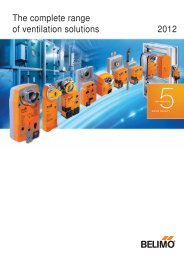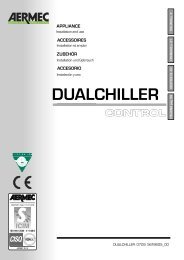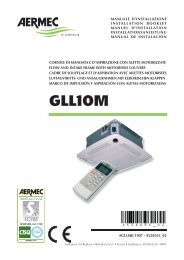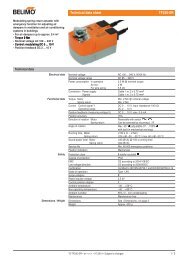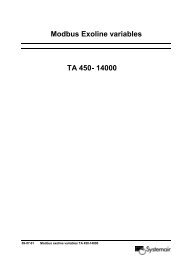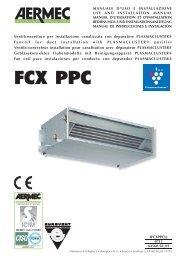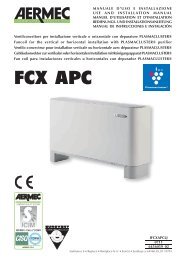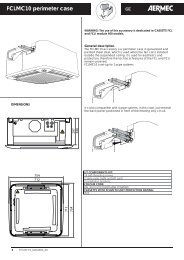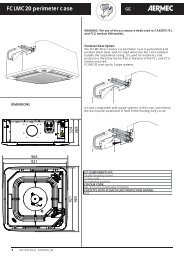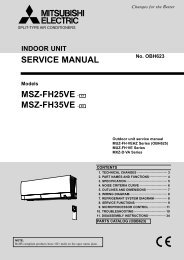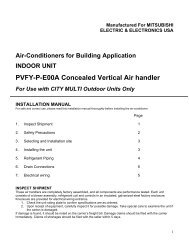Mitsubishi Electric Hydro Units Operation Manual
Mitsubishi Electric Hydro Units Operation Manual
Mitsubishi Electric Hydro Units Operation Manual
Create successful ePaper yourself
Turn your PDF publications into a flip-book with our unique Google optimized e-Paper software.
2<br />
introduction<br />
economical best Practice<br />
Air source heat pumps can provide both hot water (providing a suitable cylinder is<br />
used) and space heating all year. The system is different to a conventional fossil<br />
fuel heating and hot water system. The efficiency of a heat pump is shown by its<br />
coefficient of performance as explained in the introduction. The following points<br />
should be noted to achieve the most efficient and economical operation of your<br />
heating system.<br />
important points about heat pump systems<br />
• Domestic hot water and legionella functions are only available on cylinder units<br />
or hydroboxes plumbed to an appropriate storage cylinder.<br />
• In normal operation simultaneous DHW and space heating is unadvisable.<br />
However during periods of extremely low ambient temperature, the immersion<br />
heater (if present) can be used for DHW whilst the heat pump continues to provide<br />
space heating. Please be aware that the immersion heater, used alone, is<br />
not an efficient method to heat the whole DHW tank. Therefore it should only<br />
be used as a back up in normal operation.<br />
• The hot water produced by the heat pump is typically at a lower temperature<br />
than a fossil fuel boiler.<br />
overview of Controls<br />
Built into the cylinder unit and hydrobox is the Flow Temperature Controller3<br />
(FTC3). This device controls the function of both the outdoor heat pump unit and<br />
the indoor cylinder or hydrobox. The advanced technology means that by using<br />
an FTC3 controlled heat pump you can not only make savings compared to<br />
traditional fossil fuel type heating systems but also compared to many other heat<br />
pumps on the market.<br />
As explained in the earlier section, ‘How the Heat Pump Works,’ heat pumps are<br />
most efficient when providing low flow temperature water. The FTC3 advanced<br />
technology enables the room temperature to be kept at the desired level whilst<br />
utilising the lowest possible flow temperature from the heat pump.<br />
In room temp (Auto adaptation) mode the controller uses temperature sensors<br />
around the heating system to monitor space and flow temperatures. This data<br />
is regularly updated and compared to previous data by the controller to predict<br />
changes in room temperature and adjust the temperature of water flowing to the<br />
space heating circuit accordingly. By monitoring not only the outdoor ambient, but<br />
the room and heating circuit water temperatures, the heating is more consistent<br />
and sudden spikes in required heat output are reduced. This results in a lower<br />
overall flow temperature being required.<br />
implications<br />
• If the heat pump is being used for DHW the time at which tank heat up occurs<br />
should be scheduled using the SCHEDULE function (see page 0).<br />
Ideally this should be during the night time when little space heating is required<br />
and economy electricity tariffs can be taken advantage of.<br />
• In most situations space heating is best performed using the room temperature<br />
mode. This enables the heat pump to analyse current room temperature<br />
and react to changes in a controlled manner utilising the specialised<br />
<strong>Mitsubishi</strong> <strong>Electric</strong> controls.<br />
• Using the SCHEDULE and HOLIDAY functions prevent unnecessary Space<br />
or DHW heating when the property is known to be unoccupied for instance<br />
during the working day.<br />
• Due to lower flow temperatures, heat pump heating systems should be used<br />
with large surface area radiators or under-floor heating. This will provide a<br />
steady heat to the room whilst improving efficiency and so lowering running<br />
costs of the system as the heat pump does not have to produce water at<br />
very high flow temperatures.<br />
4



